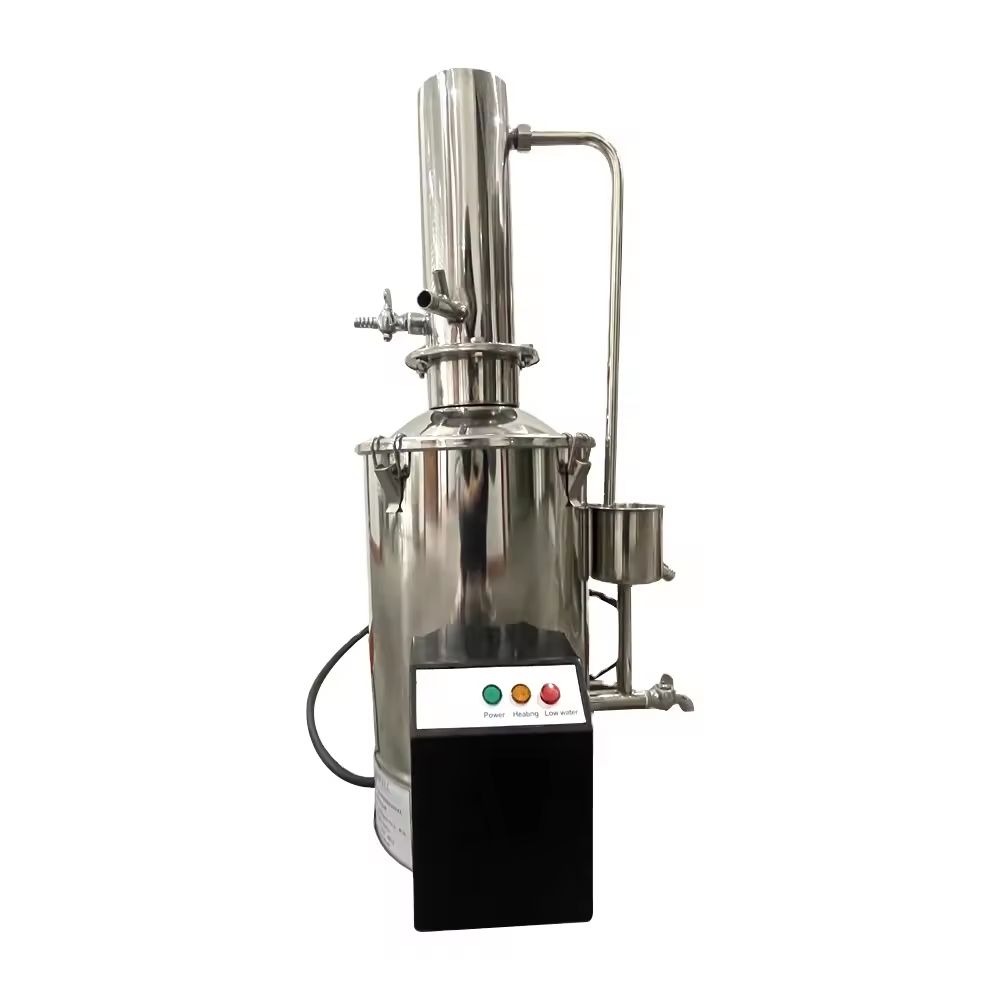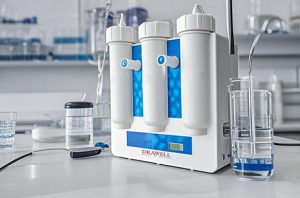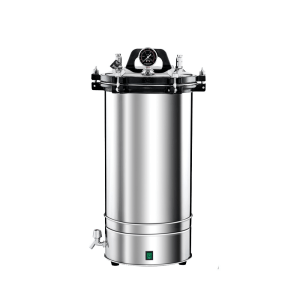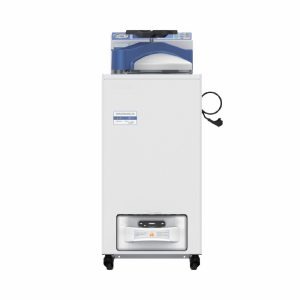In various settings such as labs, homes, and healthcare environments, water distillers serve as an effective solution for producing pure and clean drinking water. One of the most important decisions for potential buyers is choosing between plastic and stainless steel water distillers. Each has unique advantages and disadvantages in relation to safety, longevity, price, and efficiency. This article analyzes two types of water distillers to aid you in decision-making.
What are Water Distillers
Water distillers are machines that are specifically made to purify water by boiling it to produce steam and then condensing the steam back into water. The heating and cooling cycles remove the water’s impurities such as bacteria, minerals, and chemicals resulting in pure water. Water distillers are found in homes, laboratories and medical centers to ensure access to safe drinking water.
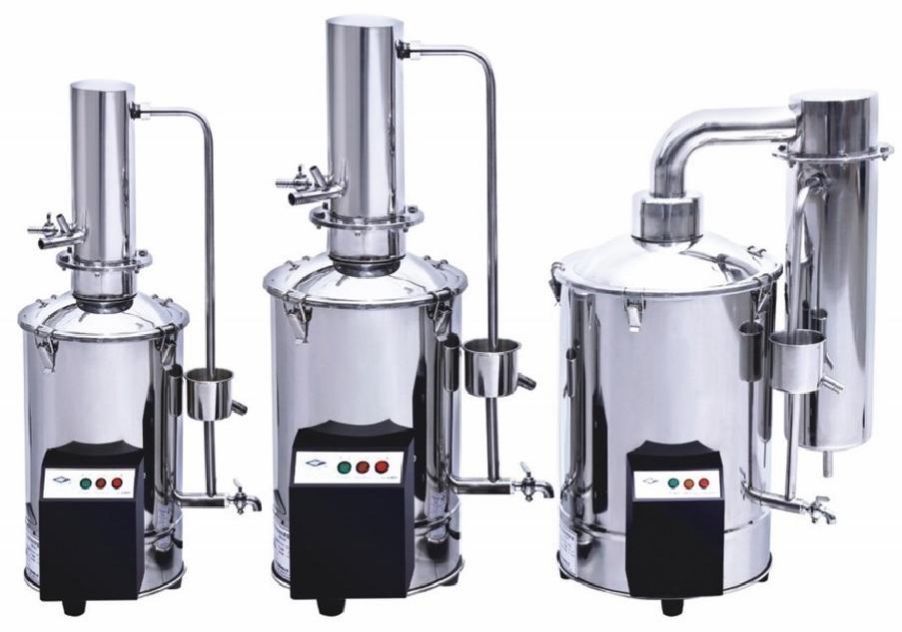
What are Stainless Steel Water Distillers
Stainless steel water distillers are one of water purification systems that work through mimicking natural cycles of hydrologic. Stainless steel water distillers are made from high-grade stainless steel, 304 or even 316, known for their robust durability, low corrosiveness. These distillers are widely used in homes, laboratories and medical stations, as well as in industries that require purified water.
Working Principle
As with all types of distillation, the process starts with charging the stainless steel boiler with water. The boiler has an integrated heating element that raises the temperature of the water to boiling point. During boiling, the water transforms into steam, releasing a portion of its impurities, including salts, heavy metals, certain organic compounds, and microorganisms.
The steam rises up and passes through a condenser, often glass or stainless steel. It is cooled to liquid form. Any resulting steam-processed water is stored in glass or food-safe plastic containers and considered contaminant-free. Certain devices may also incorporate activated carbon filters designed to capture and retain volatile organic compounds (VOCs) that may evaporate with steam.
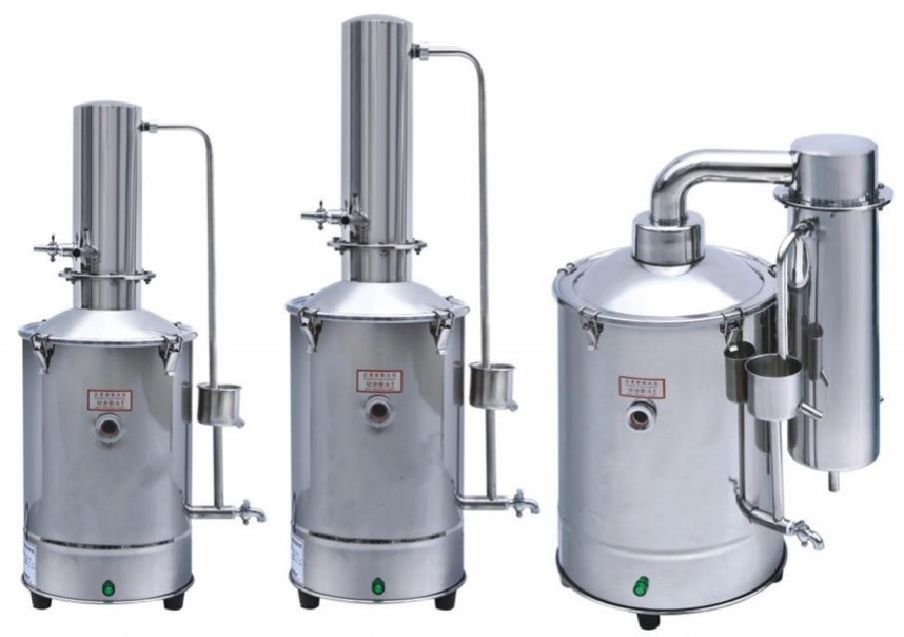
Advantages
- High Durability: The construction of the unit ensures a high degree of durability as the stainless steel is highly resistant to corrosion, rust, and mechanical wear and tear, giving it an extended operational life.
- Resistance to Heat and Pressure: Ideal for intensive use at elevated temperatures without risk of deformation or structural compromise.
- Hygienic Materials: Compared to plastic, the porous stainless steel is easier to clean and less prone to harbor bacteria or absorb odors.
- Non-chemical Leaching: Provides distilled water free of harmful chemicals that could compromise the water’s purity.
- High-performance professional grade: The equipment is used in clinics, laboratories, and other medical environments because of their dependable and consistent performance.
- Sleek Aesthetic: Works well at home or in commercial settings, adding a professional and clean touch to the environment.
Limitations
- Costlier: Compared to the other plastic versions, these are more expensive and may not fit into every budget.
- Excessively Heavy: The unit becomes less portable due to the additional weight from the components made of stainless steel.
- Requires Regular Maintenance: Heating mineral-rich water may create deposits in the chamber that need to be maintained regularly.
- Extended Warm-Up Period: Lighter materials heat up faster than stainless steel, which may affect the rate of distillation.
- Increased Volume Operation (Certain Models): Some stainless steel models may operate at a higher volume due to the build and fan used in the design.
An Overview of Plastic Water Distillers
The plastic water distillers are machines which purify water through the distillation process, which incorporates plastic materials in their construction. Unlike stainless steel models, which are entirely made of metal, plastic water distillers often incorporate a metal boiling chamber to withstand heat, while the condenser housing and collection container are made of BPA-free, heat-resistant plastic. These devices are common in households. Because they are lightweight and economical, they are preferred by many customers.
Working Principle
Water purification in a plastic distiller works somewhat like in traditional distillers. The water is placed in a heated metallic chamber and is heated until it boils and turns into steam. The steam then rises, but before undergoing a process to cool it, which is often encased in a plastic shell, allowing it to condense back to liquid. The distilled water is now free of contaminants, including microbes, heavy metals, and certain minerals. This water is stored in plastic containers such as storage jugs and containers. Certain models contain carbon post-filters that capture VOCs that may be carried during the vaporization process.
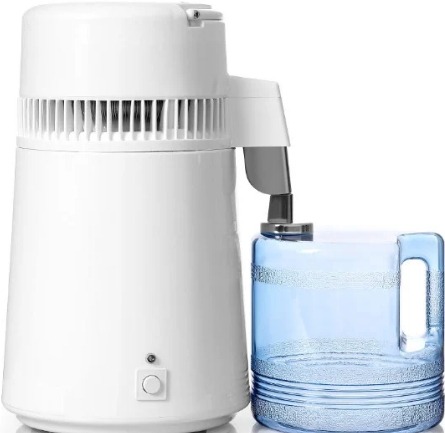
Advantages
- The cost of plastic water distillers is lower than that of stainless steel counterparts, thus making them affordable to budget-conscious consumers.
- Lightweight design makes these easy to move and transport, especially beneficial in small kitchens or for frequent use.
- Some models have ergonomic handles, water jugs, and other simple controls that enhance ease of use.
- Most water distillers are plug and play, requiring no plumbing or complex installation tasks.
- Small Size: Benefits both apartments and homes by providing a convenient countertop or space-saving option.
Limitations
- Lower Durability: With prolonged exposure to heat, plastic components are likely to crack, warp, or deteriorate.
- Potential for Chemical Leaching: Concerns exist regarding the migration of chemicals from plastics, even those that are labeled BPA-free, especially after prolonged use.
- A Shorter Life Span: Distillers composed of plastic generally have a shorter lifespan compared to stainless steel counterparts.
- Staining and Odor Retention: The distilled water is compromised in quality and flavor due to the plastic components absorbing odors or stains.
- Less Suited to High-volume Utilization: The described distillers are ideal for moderate or occasional use, but not for high-output, around-the-clock operational demand.
Key Differences Between Stainless Steel and Plastic Water Distillers
The table below contrasts these two types of water distillers. This comparison enables an informed choice based on quality, price, durability, and the user’s specific requirements.
| Feature | Stainless Steel Water Distillers | Plastic Water Distillers |
| Material | Steel made of stainless steel (boiling chamber condenser, boiler body) | A combination with stainless steel (boiling chamber) and plastic components |
| Durability | High-quality – resistance to abrasion, impact and heat | Plastic may change over time as a result of exposure to heat |
| Water Purity | Absolutely perfect – no chance of leaching | BPA-free is good, but there’s a chance of leaching when exposed to the heat |
| Weight | Heavier – less portable | Lightweight, easy to carry and manipulate |
| Cost | Greater initial investment | More affordable, budget-friendly |
| Use Case | Ideal for clinics, labs or health-conscious households | Ideal for occasional or casual home use |
| Heat Resistance | Great – ideal for repeat high-heat cycles | Plastic parts that are limited may change shape with time |
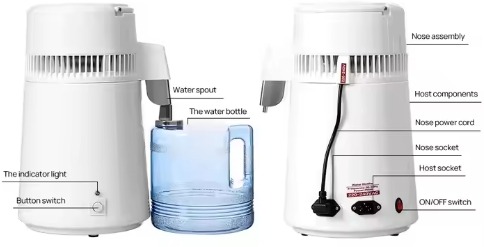
Key Factors to Look at when Deciding Between Plastic and Stainless Steel Water Distillers
- Who, When and How Often Will Use
While deciding on plastic and stainless steel water distillers, the first factor to take into account is when the device will be used and for what frequency. Stainless steel distillers are constructed to withstand wear and tear, making them ideal for frequent or large-volume water distillation, such as in homes with high water purification needs or professional environments like labs and clinics. On the other hand, plastic distillers are more suited for moderate to occasional use.
- Water Purity and Health Safety
When selecting a water distiller, both the safety of the user and the water’s purity are critical considerations. During the distillation process, stainless steel water distillers are safe because they do not release any harmful chemicals into the drinking water. This feature makes them a better choice for long-term investment, especially for those concerned about their health. Distillers made from plastic, even those labeled as BPA-free, face the risk of chemical leaching over time due to steam and heat. Such changes not only make water taste strange but can be harmful too.
- Durability and Lifespan
Durability is another important factor. When properly maintained, stainless steel water distillers have superior resistance to corrosion, physical wear, and heat. On the other hand, distillers made from plastic tend to suffer from heat-induced cracking or warping. Their lifespan is lower, too. Moreover, components made of plastic tend to retain stains and odors, which negatively affects their long-term functionality and makes frequent replacement necessary.
- Budget Considerations
Cost is a critical factor in the decision-making process. The water distillers having a case of stainless steel are more expensive due to the materials used and their longevity. On the other hand, distillers made of plastic are cheaper, which widens their appeal to consumers or hobbyists who want to try distillation without a significant financial commitment. Finding the optimal point between the budget and the expected life of the item is important in order to maximize your value.
- Portability and Space Requirements
Your choice may depend on the weight and size of the distiller in relation to space and mobility considerations. Water plastic distillers are portable as they are light and occupy smaller space. Thus, they are ideal for small kitchens and temporary installations. Stainless steel distillers are bulky compared to other models and require a significant amount of counter space or storage. This makes them less ideal for people who have limited space.
- Maintenance and Cleaning
The maintenance protocols are different for each type of distiller. While Stainless steel distillers are easier to maintain and clean because they do not stain or hold odors, they do require frequent descaling to prevent mineral build-up. The cleaning and maintenance of plastic distillers is more complicated. They can easily develop discoloration over time, requiring more frequent cleaning. Moreover, certain components of these plastic distillers may need to be replaced due to damage or degradation.
- Aesthetic Appeal and Build Quality
Lastly, both aesthetic appeal and build quality are important factors to consider, especially for those wishing to remodel their kitchen or wanting high-end equipment. Water distillers made of stainless steel come with a polished and sleek appearance which is ideal for modern kitchens and laboratories. While practical, plastic distillers with their lower tier build lack sophistication and may not appeal to everyone’s tastes.
For the best value, durability, and safety for the family, a stainless steel water distiller is recommended despite the higher price.
Choose a plastic water distiller if it is your first time and cost and ease of use are the most important factors, in addition, you’re ready to compromise on the long-term value and purity.
Final Thoughts
For the majority of people, stainless steel water distillers are the superior option due to their safety in the construction, durability and endurance. If budget is an issue then a BPA-free, high-quality plastic water distiller could be a viable choice.
Related Products Recommendation
Get Quote Here!
Latest Posts
What Next?
For more information, or to arrange an equipment demonstration, please visit our dedicated Product Homepage or contact one of our Product Managers.

